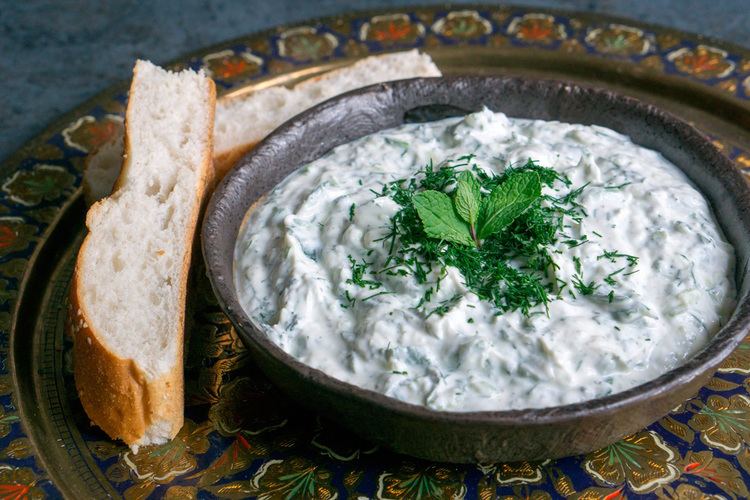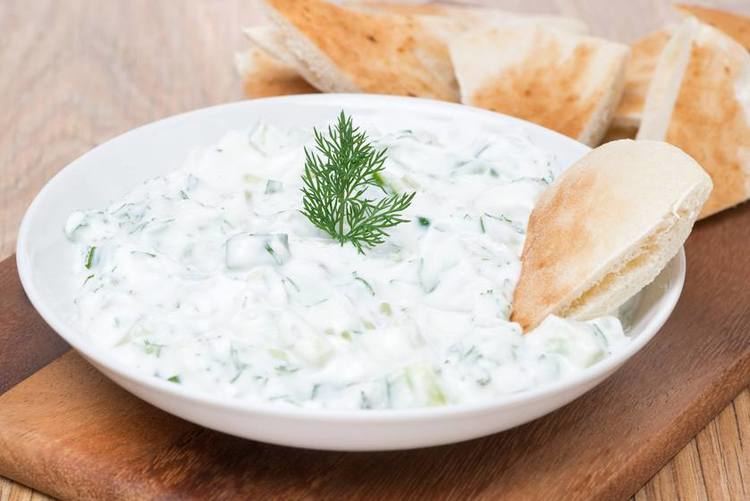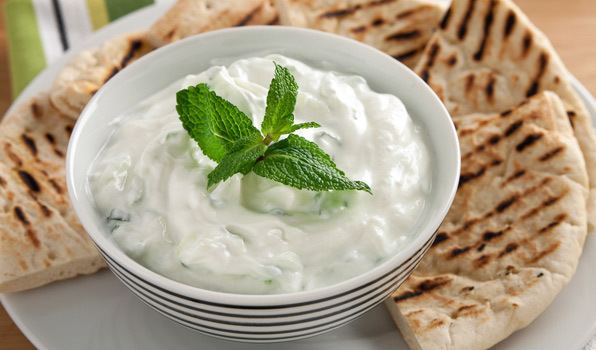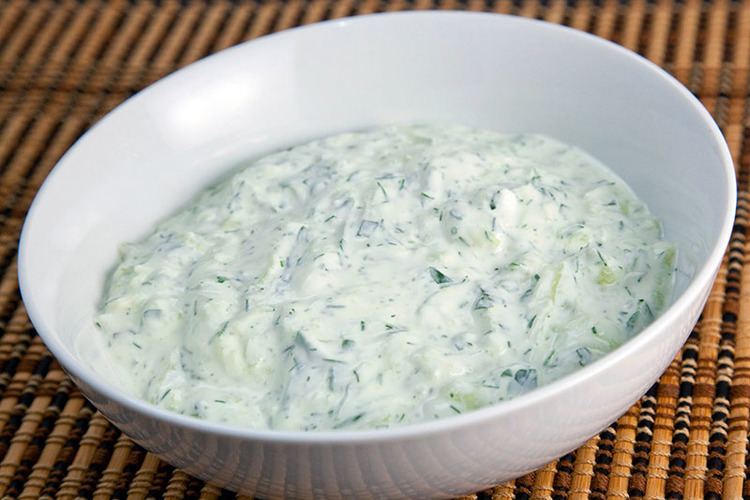Serving temperature Cold | ||
 | ||
Course Appetizer, Side dish, Meze Main ingredients Places of origin Armenia, Bulgaria, Cyprus, Greece, Turkey Similar | ||
Tzatziki sauce how to make tzatziki greek garlic yogurt sauce
Tzatziki ( /tætˈsiːki/, /tsætˈsiːki/, /tɑːtˈsiːki/; Greek: τζατζίκι [dzaˈdzici] or [dʒaˈdʒici]; Turkish: cacık) is a sauce served with grilled meats or as a dip. Tzatziki is made of salted strained yogurt (usually from sheep or goat milk) or diluted yogurt mixed with cucumbers, garlic, salt, olive oil, sometimes with vinegar or lemon juice, and some herbs like dill, mint, parsley, thyme etc. It is always served cold.
Contents
- Tzatziki sauce how to make tzatziki greek garlic yogurt sauce
- How to make greek tzatziki sauce akis kitchen
- Etymology
- Balkans
- Cyprus
- Greece
- Middle East
- Turkey
- Haydari
- Similar dishes
- References

How to make greek tzatziki sauce akis kitchen
Etymology

The Greek word tzatziki comes from the Turkish word cacık which in turn is likely a loanword from the Armenian word cacıg.

The root cac is likely related to several words in Western Asian languages. Persian zhazh (ژاژ) refers to various herbs used for cooking. Evliya Çelebi's 17th-century Seyâhatnâme travelogue defined cacıχ (cacıg) as a kind of herb. Ahmet Vefik Pasha's 1876 Ottoman Turkish dictionary defined cacık as an herb salad with yogurt. This remains the most common definition today.
Balkans
There are dishes similar to cacık called tarator in many Balkan countries.

In Bulgaria and Serbia, the same dish is known as "dry tarator" (Bulgarian: сух таратор, Macedonian: сув таратур, Serbian: сув таратор), or as "Snezhanka" salad (салата "Снежанка"), which means "snow white salad", and is served as an appetizer. During preparation, the yoghurt (Bulgarian: кисело мляко, Macedonian: кисело млеко, Serbian: кисело млеко) is hung for several hours in a kerchief and loses about half of its water (drained yogurt, Bulgarian: цедено кисело мляко and Serbian: цеђено кисело млеко. The cucumbers, garlic, minced walnuts, salt and vegetable oil are then added.

In Bulgaria, tarator is a popular meze (appetizer) but also served as a side dish along with Shopska salad with most meals. Sunflower and olive oil are more commonly used and walnut is sometimes omitted. Tarator is seasoned with garlic and dill both of which can be omitted if so desired. Tarator is a popular dish in Bulgaria. A salad version of tarator is known as "Snowwhite salad" (Bulgarian: салата Снежанка- "salata Snezhanka" or "Snejanka" ), also called Dry Tarator. It is made of thick (strained) yogurt, without water. It can be served as an appetizer or as a side to the main meal. It is a common refresher during the summer.

Tarator is a popular salad and dip in Serbia rather than a soup; it is also known as "tarator salata". It is made with yogurt, sliced cucumber and diced garlic, and served cold.

In Albania Tarator is a very popular dish in summer time. It is usually served cold and is normally made from yoghurt, garlic, parsley, cucumber, salt and olive oil. Fried squids are usually offered with Tarator.
Cyprus

In Cyprus, the dish is known as talattouri (cf. tarator), and recipes often include less garlic and includes the herb mint, unlike the version used in Greece.
Greece
Greek-style tzatziki sauce is served with grilled meats or may be served as a mezze alongside other mezzes, dishes and ouzo. Tzatziki is made of strained yogurt (usually from sheep or goat milk) mixed with cucumbers, garlic, salt, olive oil, and sometimes lemon juice, and dill or mint or parsley.
Middle East
Similar dishes in Iraq are known as jajeek. They are normally served as meze to accompany alcoholic drinks, especially Arak, an Ouzo-like drink made from dates.
A similar dish is made in Iran, called mast-o-khiar literally meaning yogurt with cucumber. It is made using a thicker yogurt, which is mixed with sliced cucumber, and mint or dill (sometimes chopped nuts and raisins are also added as a garnish).
Turkey
Turkish cacık is made of yoghurt, salt, olive oil, crushed garlic, chopped cucumber, mint. Among these ingredients, vinegar (mostly white grape or apple), lemon juice, and sumac are optional. Dill and thyme (fresh or dried) and sumac and paprika may be used alternately.
Mostly, cacik is served to accompany main dishes. As a side dish, it is diluted with water, which results in a soup-like consistency. If consumed as a meze, it is prepared undiluted but follows the same recipe. Often, dill and thyme are added as well. Ground paprika may also be added if it is prepared as a meze and to be served with some grilled meat, other mezes or rakı (a Turkish spirit similar to Greek ouzo). More rarely, it is prepared with lettuce or carrots instead of cucumber under the name of kış cacığı (winter cacık) or havuç tarator.
In Turkish and Greek cuisine, purslane salad is very common and since such salad is made with yoghurt and cooked or uncooked purslane and thus may also be called cacık.
Carrots and other vegetables can be added to cacık. In Turkish cuisine when cooked or uncooked carrot is added to cacık it is sometimes called havuç (carrot) tarator as also in Balkan cuisine.
Haydari
Haydari is a dish of the cacik type, consisting of certain herbs and spices, combined with garlic and yoghurt. It differs from cacık in that the recipe contains no cucumber and calls for strained yoghurt or labne. It is served purely as a meze,being more pungently appetising - by virtue of being saltier, more acidic and of a thicker consistency - than cacık.
Similar dishes
A variation in the Caucasus mountains, called ovdukh, uses kefir instead of the yogurt. This can be poured over a mixture of vegetables, eggs and ham to create a variation of okroshka, sometimes referred to as a 'Caucasus okroshka'. Mizeria is another variation from Poland, using the same ingredients but substituting sour cream for yogurt.
In South Asia a similar dish is made with yoghurt, cucumber, salt and ground cumin (sometimes also including onions) called raita.
